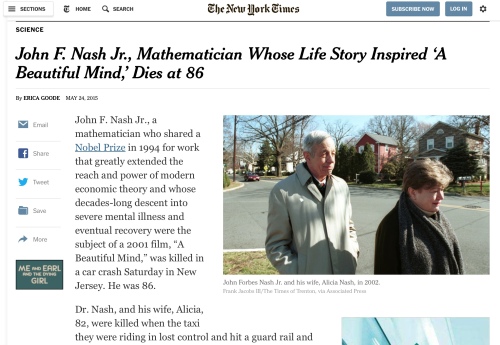 I saw a bit of sexism on display by media and Twitter users in noting the deaths of John and Alicia Nash, the couple whose lives were portrayed in the movie “A Beautiful Mind.”
I saw a bit of sexism on display by media and Twitter users in noting the deaths of John and Alicia Nash, the couple whose lives were portrayed in the movie “A Beautiful Mind.”
The Nashes died in an accident Saturday while riding in a taxi on the New Jersey Turnpike.
Two people died in the crash. Admittedly, one of them was a Nobel Prize winner whose mind was immortalized by Hollywood as “beautiful.” But the other passenger killed in the crash, was also a powerful character in the same movie, her portrayal by Jennifer Connelly winning an Oscar. But Alicia got no mention in the headline, tweet or lead of the New York Times:
Breaking News: John Nash, Nobel-Winning Mathematician Portrayed in ‘A Beautiful Mind,’ Dies in Crash http://t.co/Hb5UQ9Wiyj
— The New York Times (@nytimes) May 24, 2015
As you can see from the screenshot above, Alicia Nash was in the photo the Times used and did get a mention in the second paragraph.
Clearly John Nash was the more famous half of the couple. He did have the “Beautiful Mind,” and his death was absolutely noteworthy. But isn’t an elderly couple dying together newsworthy in itself? Don’t lots of couples hope they will die together, rather than leaving one to mourn the other? Her death is an important part of this story.
And, oh, by the way, she was an outstanding and memorable character, too, in that movie. Wouldn’t her death, if she had died alone, have been worthy of a New York Times obituary (even with the gender imbalance of Times obits), headline and tweet? If she were the brilliant mathematician and Russell Crowe had won an Oscar for portraying her husband (he was nominated for an Oscar for “A Beautiful Mind”), I think we can be pretty sure they would have shared mentions in the headlines and tweets.
And if you want to defend leaving her out, don’t use Twitter’s character count or the tighter counts of headlines as an excuse. Alicia is six characters, wife is four. Add a comma or an ampersand to either of those words and you can add an important newsworthy person and element to your tweet or headline for less than 10 characters. I’d like to hear a defense if you have one, but not that one.
While I single out the Times because it’s the most prominent newspaper, it was not alone in its focus on a single death from the crash:
‘Beautiful Mind’ Mathematician John Nash, Jr. Dies In New Jersey Car Crash http://t.co/gLdb78z5AC — NPR News (@nprnews) May 24, 2015
Nobel Laureate John Nash, who inspired ‘A Beautiful Mind,’ has been killed in a taxi crash http://t.co/vSrv3NurkA — Bloomberg Business (@business) May 24, 2015
John Nash, mathematician portrayed in A Beautiful Mind, dies in taxi crash at 86 http://t.co/DPkpk6JOAX pic.twitter.com/Oua3Kj7Cl6
— The Guardian (@guardian) May 24, 2015
Note that the New York Post uses a photo of Russell Crowe, but not Alicia Nash.
John Nash, Nobel prize winner & inspiration for “A Beautiful Mind,” was killed in a cab crash http://t.co/XOcy7uQx5zpic.twitter.com/455lXg4maI — New York Post (@nypost) May 24, 2015
John F. Nash Jr. dies. He was 86. The Nobel laureate was subject of “A Beautiful Mind.” http://t.co/8N2Pmqj8z3 pic.twitter.com/0ODD9NpXzO
— Washington Post (@washingtonpost) May 24, 2015
These media tweets didn’t mention Alicia Nash, but the accompanying headlines did:
‘A Beautiful Mind’ mathematician killed in New Jersey taxi crash http://t.co/Yax13AoOZP
— TIME.com (@TIME) May 24, 2015
No charges expected in NJ Turnpike crash that killed John Nash, prosecutor’s spokesman says – @noahyc http://t.co/16w7xmVgRi
— Breaking News (@BreakingNews) May 24, 2015
This media tweet didn’t mention Alicia, but the cutline with the photograph did:
John Nash, ‘A Beautiful Mind’ mathematician, dead at 86 http://t.co/rnu7KMzOYB — Rolling Stone (@RollingStone) May 24, 2015
To be fair, some media outlets and journalists did mention Alicia Nash in their tweets about the crash, rarely by name:
“A Beautiful Mind” Mathematician John Nash And Wife Killed In Taxi Crash http://t.co/DbJwWhv8I4 pic.twitter.com/ZrNlH4Qnl3
— BuzzFeed News (@BuzzFeedNews) May 24, 2015
John Nash, mathematician who inspired “A Beautiful Mind,” dies in taxi wreck with his wife. http://t.co/W9udQZc6Ga pic.twitter.com/IKL51dOLhP — CNN Breaking News (@cnnbrk) May 24, 2015
Nobel Prize winner John Nash, the inspiration for a ‘A Beautiful Mind’, killed in car crash along with wife http://t.co/WhOoiDH9h3
— Yahoo News (@YahooNews) May 24, 2015
John Nash, wife, ‘A Beautiful Mind’ inspiration, die in New Jersey Crash http://t.co/9USwPYF5Pg — Los Angeles Times (@latimes) May 24, 2015
Princeton mathematician John Nash and his wife, Alicia, are killed in a car accident http://t.co/VpkSypPwQH pic.twitter.com/fxaijvb8u5
— Quartz (@qz) May 24, 2015
Police: ‘Beautiful Mind’ mathematician John Nash, wife die in New Jersey turnpike crash, AP reports — Los Angeles Times (@latimes) May 24, 2015
John Nash, ‘A Beautiful Mind’ mathematician and wife reportedly killed in car crash. http://t.co/4vZMqYcORk pic.twitter.com/yZ4G7TuzyY
— Mashable (@mashable) May 24, 2015
Famed ‘A Beautiful Mind’ mathematician John Nash, wife killed in NJ taxi crash, police say http://t.co/wSYfwzKmmG — Greg Mitchell (@GregMitch) May 24, 2015
Update: Here’s a tweet, called to my attention in a comment, that gave Alicia her due:
#RIPAliciaNash Love the one you're with. http://t.co/aPe8UMHq0K pic.twitter.com/zVmjjYxeDV
— Mary Grace Kosta (@marygkosta) May 24, 2015
I’ll be inviting response from New York Times editors and will add it if they send anything. If you wrote one of the tweets above and would like to respond, I invite your feedback in the comments or on Twitter (I’ll add your tweet to the post if you mention me).
But let’s close with a little recognition for Alicia Nash, who died with her husband, John, in a crash Saturday:
Update: Tom McKay tweeted at me that he mentioned Alicia Nash in his headline.


